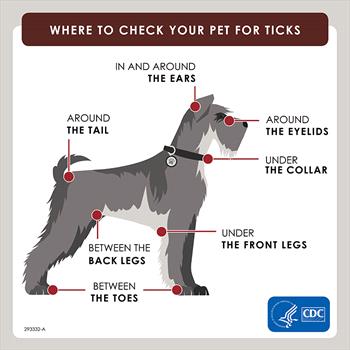Check dog for ticks

Illustration by CDC
Anaplasmosis is a disease affecting dogs (and rarely cats) caused by Anaplasma phagocytophilum. This infectious organism is an unusual type of bacteria known as a rickettsial agent/bacterium. A tick bite transmits the disease. As with other tick-borne diseases, a tick must remain attached to your pet for more than 24 hours to transfer the infection.
Anaplasmosis has been reported throughout the world in a variety of animals.
Signs of Anaplasmosis
Signs usually begin one to two weeks after the tick bite. Anaplasmosis organisms enter the bloodstream and live in the animal’s white blood cells, which normally aid in fighting infections. This invasion of circulating white blood cells creates inflammation throughout the body. Signs can include poor appetite, acting very tired, and fever. Joints are commonly affected, making your pet seem stiff or painful or appear to have trouble walking. Weight loss, enlarged lymph nodes (swellings beneath the neck, in front of the shoulders, in the groin, and behind the knees), breathing fast, and pale gums may also be seen. A bloody nose, black or bloody stool, or bruising may occur.
Not all pets will have symptoms. Some will only appear sick for a short time and then start to improve. Why this happens isn't fully understood, but it may be associated with a pet’s ability to fight off the infection.
Diagnosing Anaplasmosis
Your veterinarian’s physical examination may not be useful as a sole means of diagnosis; however, if a pet shows signs of anaplasmosis, it will point the veterinarian in the right direction for testing. A complete blood count, also known as a CBC, may indicate a decrease in red blood cells (anemia) or a decrease in platelets (thrombocytopenia). Anaplasmosis can be diagnosed by finding the organisms in a blood sample using a microscope.
Additional lab tests may be needed to confirm the diagnosis or check the health of internal organs, like the liver and kidneys. Occasionally, confirmatory tests can be positive in a dog or cat that does not show signs of infection. This does not necessarily mean your pet has anaplasmosis, but it can indicate they were exposed to it at one point. Your veterinarian will then need to consider the exam results, signs, and the lab work to make a proper diagnosis. In some cases, antibody testing is performed twice, several weeks apart, to monitor an increase or decrease in your pet’s antibody levels. This can help determine actual infection versus exposure.
Treatment and Recovery
Anaplasmosis is treated with certain types of antibiotics, most commonly doxycycline, and the treatment is usually prescribed for two to four weeks. Pets usually start to feel better within a few days of starting antibiotics; however, it takes at least two weeks to clear the infection, so make sure to continue giving medication as your veterinarian recommends. The longer, four-week course of antibiotics tends to be given if your pet also has Lyme disease, but it depends on the specific case. A blood transfusion may also be needed if the anemia or thrombocytopenia is severe. Most dogs and cats make a full recovery.
Prevention
No vaccine is available to prevent anaplasmosis. The best form of prevention is tick control, either through treating your yard or applying tick preventive medications to your pet. Consult your veterinarian for the best prevention options for each pet.